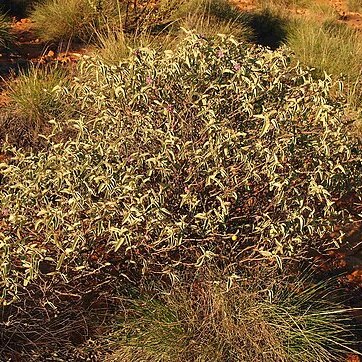Sprawling perennial herb with stems to 1 m long, green or purplish-green, densely pubescent with minute stellate hairs; prickles to 1 cm long, scattered on stems, petioles and leaf-surfaces, dense on calyx. Leaves elliptic; lamina 3–6 cm long, 15–25 mm wide, sometimes larger, slightly discolorous, entire to slightly undulate; petiole mostly 10–30 mm long. Inflorescence short, 1–6–flowered; peduncle absent or to 5 mm long; pedicels 5–10 mm long. Calyx 5–6 mm long; lobes narrowly triangular to linear, 3–4 mm long. Corolla stellate, deeply incised, 15–20 mm diam., white or pale lavender. Anthers 4–5 mm long. Berry globular, 10–20 mm diam., purplish-green. Seeds 2.5 mm long, light brown.
A prickly herb. It keeps growing from year to year and develops woody stems. It grows 0.9-2 m high. It spreads 0.9-2 m wide. The plant is covered with felt like hairs. The stems have fine, sharp, yellow prickles. These are 6 mm long. The leaves are oval shaped. The flowers are purple. They occur in groups or 3-7. The fruit is round and 1.5-2 cm across. These are yellow-green and turn purple when ripe. There are 2 compartments on the fruit.

